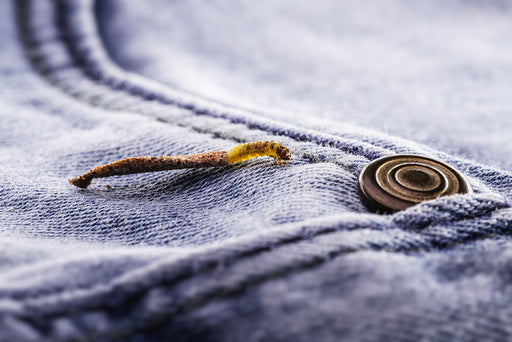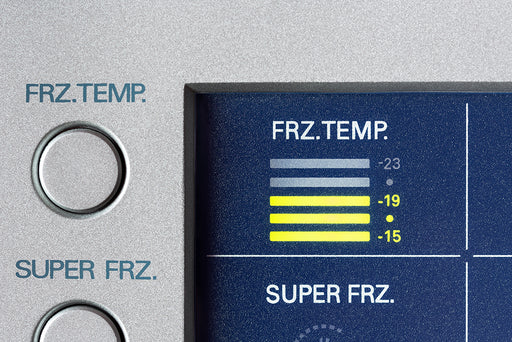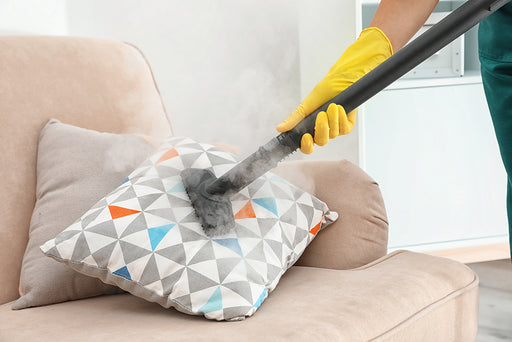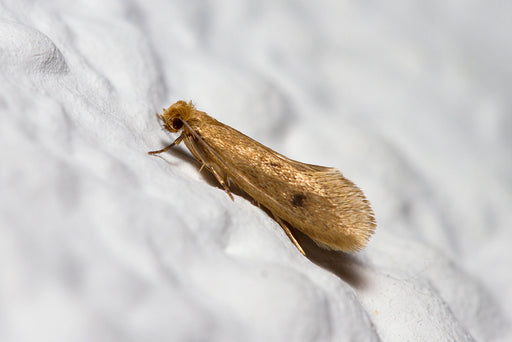Does Steaming and Freezing Kill Clothes Moths?

Everyone knows that moths can be destructive, agitating, and downright disappointing to discover in a storage bin or wardrobe. Have you been wondering whether you can use a steam cleaner to remove these insects and their eggs? If so, you have come to the right place. Here, we are going to walk you through every aspect of the moth steam cleaning process. We will even discuss how you can use your freezer to freeze Clothes Moths away! Before you know it, you’ll be a pro at eliminating moths from your favorite sweaters, decorations, and fine garments. Let’s dive in!
The Destructive Tendencies of Clothes Moths
The larvae of Clothes, Carpet and Pantry Moths consume natural materials and fibers as food. Clothes Moths are responsible for causing damage to your favorite woolens and textiles when they are in their ravenous larval stage. After hatching, these larvae destroy clothing and other natural fabrics as they tunnel their way through them, consuming everything in their path. This can be bad news if you are storing feathers, leather, fur, silk, wool, or pretty much any fine fabric. For this reason, it’s very important to identify an infestation as soon as possible and take steps to eliminate it entirely.
Understanding the Moths Steam Cleaning Process
Steam cleaners are great for removing creases and making garments look fresh. However, they can also be a fantastic way to eliminate Clothes Moths. So how exactly does steam kill moths? Mainly, by killing anything in hidden moth eggs and keeping them from hatching. The high temperatures of a steamer are responsible for this. As such, if you have items that are hard to wash but easy to steam clean, a steam cleaner might be the perfect extermination tool.
Steam cleaners can kill Clothes Moths at any point in their life cycle. This is because they work at high temperatures. Anything above 50 degrees Celsius, or, 122 degrees Fahrenheit, will cause the proteins of a moth to denature. This makes a steamer (which generates steam that is higher than 212 F (the boiling point of water) ideal for getting the job done.
So you’ve found evidence of moths. Now what?
Let's pretend that you just found evidence of Clothes Moths in a wardrobe full of wool sweaters, silk scarves, and feather costume pieces. How frustrating! You may wonder why this is happening and where the moths came from. Moth infestations happen in stages. You see, as adults, female moths choose dark, quiet places to lay their eggs. A wardrobe full of natural materials is a prime target.

With lots of things for the larvae to eat, a well-stocked wardrobe can serve as an all-inclusive resort and buffet for moth larvae! Once a moth’s eggs hatch, the larvae begin feeding on proteins found in natural materials. The main protein that the larvae eat is keratin. Then, they pupate and hatch into adults. Alas, from here, the cycle starts again.
Be Aware, Moth Larvae Feast on Keratin and Organic Materials
Premium materials like cashmere, leather, silk, and wool are all loaded with keratin. However, it doesn't end there. Keratin can also be found in dust. We won’t get into it here, but dust is usually made of organic materials like skin cells, remnants of hair, and oils. Just another thing for moth larvae to eat! Pantry Moth Larvae dine on crumbs, sweat, food stains, pet kibble, and any unsealed dry food stuff, even chocolate! This means that even synthetic fibers and cotton blends are not safe from moth larvae if they are dusty or dirty.
Breaking Up the Party and Removing Moths
Obviously, you don’t want your things to get damaged. So, it’s best to stop an infestation in its tracks. The sooner you act, the easier it will be to get moths out of your house.
Signs of Clothes Moths in a wardrobe (or anywhere else) include larval casings, evidence of holes in clothes, dead adult moths, dead larvae, and worst of all, live larvae. If you see these signs, start by completely emptying out your wardrobe. Then, begin eliminating moths from your life.
Effectively Get Rid of the Moth Infestation
Any garments that are made of natural materials should be set aside and inspected for damage. Anything that is beyond repair should be discarded meticulously. Put discardable items in a plastic trash bag and tie it shut when you are done. That way, you won't bring moths back into the rest of your home. Set the other non-damaged items aside. You will sort them out next. Position Moth Traps in our home where you suspect that moths are present.
Sort Through Infested Items and Bag Them
Remove any salvageable clothing items that can be hand washed or dry cleaned. Put them in a separate trash bag to keep any eggs from falling off as you take things outside, to the dry cleaners, or even through the house to your washroom. After all, moth eggs are extremely small. It is very difficult to see them with the naked eye and it's better to be safe than sorry.
Assume that any other clothes or natural fabrics near an infestation are also infested or contain moth eggs. Separate things based on whether they can be washed, dry-cleaned, or must be steamed clean. Keep in mind that if you have wool or cashmere items, you will want to freeze them instead of using a steam cleaner. Steam cleaning wool clothes can cause problems, as heat and wool do not mix. We’ll cover how to freeze garments to kill moths in another section. After everything you want to save is bagged and sorted, it is time to clean the area where the infestation is.
Clean the Area Meticulously
Before you move on to steam cleaning or freezing your items, you must first clean out your wardrobe. Moth eggs are sometimes hidden in cracks and crevices and won't necessarily be on clothing alone. A solution of water and vinegar is a great natural moth egg remover that can be used to spray and wipe down your wardrobe.
How to Steam Moths Out of Your Clothes

So you have cleaned up a moth-infested area and now have bags of potentially infested items that need to be tended to. If you have things that can’t be washed, frozen, or dry cleaned, it may be time to break out the steam cleaner. Similarly, any nearby drapes, rugs, or furniture that may be infested could potentially be steam cleaned, depending on their care labels. The steam cleaning process takes a little bit of skill but can be a great alternative for items that can’t be frozen, dry cleaned, or washed.
Killing Moths with the Steam Cleaning Process
Once your steamer has been filled with water and warmed up to the required temperature, you will glide it up and down each item that you suspect harbors moth eggs. Pay special attention to the crevices and creases. These areas can be extra attractive to female moths looking to lay eggs. Also, thoroughly steam any areas on a garment that tend to get dirty. For instance, areas like cuffs, under arms, and pockets, will need to be steamed well.
The steam will cool quickly once it is expelled. Therefore, make sure the steamer head is close enough to the material to ensure high heat comes through to kill any eggs. Work at a steady pace. Position the head of the steamer tilted against the fabric at a slight angle rather than directly putting it onto the fabric. Otherwise, you could end up with watermarks.
Practice Makes Perfect
Steaming garments takes a little bit of practice and skill. As such, you may want to “test steam” something of little value before actually steaming a high-quality item. A sheet or a pillowcase is a great item to practice on. Remember, the goal here is to ensure that any infested areas reach high temperatures for a long enough time to kill any eggs, but also, not so long that damage occurs.
Use Preventative Measures to Keep Moths from Returning
After cleaning everything out and steaming your things, it’s time to implement a good defense that will keep moths from returning. After all, if Clothes Moths like your home, you don’t want to have a repeat visit. The good news is there are many ways to prevent moths from returning. You can use Moth Traps which will attract the active male moths and help break the breeding cycle, or natural deterrents such as Cedarwood. Herbal moth repellent sachets are another great way to keep moths from coming back. Hang natural sachets with cedar, lavender, mint, or other moth-repellent herbs to freshen up a space and keep moths away.
What About Freezing Moths?

Feathers, fur, leather, and other similar materials might not respond well to the moisture of a steam cleaner. Plus, woolen clothing items are not good to heat up. In these situations, your freezer is the perfect solution! All you need to do is place any potentially moth-egg-infested items into an air-tight plastic bag. Tie the bag shut and place it in your freezer for 72 hours. The cold temperatures of your freezer should take care of any eggs or larvae. Then, you can clean them as needed.
FAQs on Freezing and Steam Cleaning Moths
Now that you know how to use your steamer and freezer to kill moth eggs, let’s go over some frequently asked questions on the matter. That way, you can eliminate the guesswork and focus on eradicating moths from your home!
Can you kill Clothes Moths by freezing them?
Yes! Sometimes, moth-infested items are not easy to steam clean, dry clean, or wash. In these instances, your freezer is a fantastic tool that can be used to kill moth eggs. Wool sweaters, cashmere garments, feathers, and furs, for instance, are great candidates for the freezer method.
Does steaming get rid of moths?
Steaming can be used to kill moth eggs on any fabrics or materials that are safe to steam clean. The high temperatures of your steamer will boil the eggs and prevent them from hatching. For carpets, a steamer is a great way to rid yourself of a Carpet Moth infestation. Freezing will kill live larvae or adult moths on clothes or in your closet and you may also consider fumigation if your infestation is persistent or larger than expected. For more information on this you can read our Clothes Moths Kit Guide which gives guidance about using chemical products in line with our Traps.
Will steam kill Wool Moths underneath carpets?
If you have wool carpets, they should be steam cleaned at least once a year. Steam cleaning your wool carpets will kill any Carpet Moth eggs or larvae hidden there. Keep in mind that carpets and clothes are very different. Heat is like Kryptonite to wool clothing. While wool carpets are fine to steam (since they will not shrink), you should use other methods to get rid of moths on wool clothing items. Instead of using a steamer on your wool garments (sweaters, hats, scarves, etc.), place them in a freezer for 72 hours. Then, wash them on a gentle, wool-safe cycle.
How to kill moths on upholstery?

Carpets and upholstered furniture are easy to clean using a steam cleaner. The boiling hot steam kills moth eggs on contact. Underneath carpets or couch cushions, steam cleaning kills larvae as well. Depending on the severity of the infestation, you may also want to consider using moth-killing sprays or fumigation.
How long to freeze wool to kill moths?
A household freezer is easily one of the best ways to eliminate moths in all life stages from a variety of fabrics. To kill moths, bag any suspicious items and keep them in the freezer for 72 hours.
Does freezing kill moth larvae?
Yes, moth larvae will die if exposed to cold temperatures. So, freezing them is a great way to get rid of your moth problem.
How cold does it have to be to kill Clothes Moths?
To kill Clothes Moth Larvae using the freezer, your freezer must be set below 18 degrees Fahrenheit or -8 degrees Celsius. The items must be kept in the freezer for a minimum of 72 hours. It is also important to note that the abrupt temperature change is what kills moth larvae. So, make sure that the items you are going to freeze are first warmed to room temperature (about 70 degrees Fahrenheit) before being frozen.
Which moths eat clothes?
The pestilent species responsible for tunneling through your clothing and causing damage are the Clothes Moth Larvae, not the Clothes Moth. The moths will lay eggs in dark, quiet places. After the eggs hatch, they grow into ravenous larvae. The larvae are what cause all the trouble. So, preventing moths at all stages of their life cycle is important.

About MothPrevention
MothPrevention® speak to customers every day about their clothes moth issues - clothes moths are a species that are ever increasing and that can cause significant damage to clothes, carpets and other home textiles.
To date, we’ve helped over 250,000 customers deal with their moth problems. We have developed professional grade solutions including proprietary pheromones and trap design, not available from anybody else in the USA.





